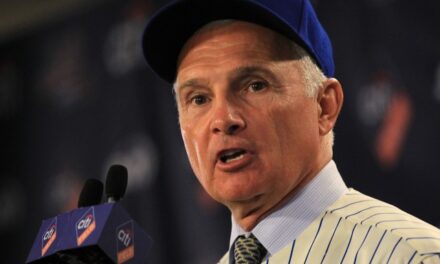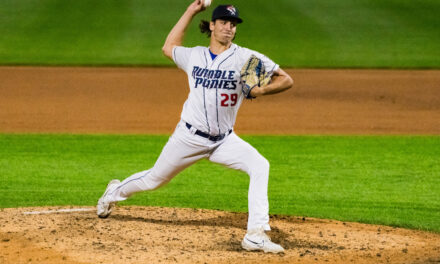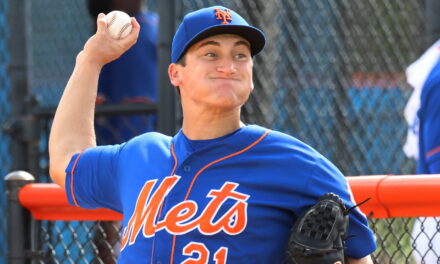
I had the pleasure of speaking with Eno Sarris, national baseball analytics writer for The Athletic last week.
Sarris previously wrote for FanGraphs and has been a member of the Baseball Writers Association of America since 2012.
We touched on a number of subjects, including the current labor environment in Major League Baseball, as well as what’s in store for this year’s incarnation of the New York Mets. Enjoy!

MMO: The word collusion is being tossed around liberally these days. The last two offseasons certainly suggest something’s not right. Judging by your reaction to Tom Verducci’s article for Sports Illustrated on Tuesday, it’s clear that you disagree with his statement that “free agency is fine”. Could you expand on your current feelings about the situation?
Eno Sarris: I think the middle class is disappearing. You look at deals like Todd Frazier‘s, Asdrubal Cabrera‘s, Wilson Ramos‘ deal. They are these under-market deals that are for league-average players and they used to be bigger than they are now. Teams will say “Oh, we’re just getting smarter and we’re not spending on 33-year-olds the way we used to”, and that’s fine. The problem is, CBA rules have limited other ways that you can spend money on players.
You can’t spend more money in the draft anymore, that’s all slotted. You can’t spend more money on the international market anymore, that’s been slotted. So, basically, money that’s not going to the middle-class of players is not going anywhere. And if you want to say the stars are still getting paid — that’s somewhat true, they’re still doing ok.
But, if you adjust Manny Machado‘s deal to today’s dollars, it’s actually only the tenth-biggest contract of all-time. Which is weird because baseball just recorded their biggest profits of all-time, so there’s something off. The stars are still getting paid but they’re not quite getting paid like they used to. The middle-class is still getting paid but not quite like they used to. And role players? They had to take one-year deals. Asdrubal Cabrera is going to be a league-average this year. He took a one-year deal for $4 million.
That money’s not going to the players in some other way. The league-minimum salary has gone up 38 percent since the last CBA (2016) I think, and profits have gone up 68 percent. Young players aren’t getting more in arbitration, necessarily. The middle-class and the role players are disappearing. There’s basically been deflation in the market for two straight years, and the last time that happened was the 1994 strike.
MMO: Do you think what’s happening now is a precursor to another work stoppage?
ES: You know, there’s a couple of interesting things on the table here. [A proposed] expansion is an interesting thing for [MLB commissioner Rob] Manfred to be talking about because expansion means another 50 or so jobs, and that’s a significant bump. And there are more minor-league jobs so it’s not just 50 or so. It’s an infusion of opportunity for the players.
There’s also talk of “how can we ensure that every team is being competitive”. That’s an interesting thing to talk about, too, because you can come up with salary floor initiatives, or just ways to sort of encourage teams like the Rays or the Marlins or whoever to spend a little more.
I think they’re sort of drawing some battle lines. I hesitate to say if [a strike] is definitely going to happen, but I would say that these players are pretty upset. And I have heard the c-word (collusion, naturally) from multiple players which — and I haven’t been in the clubhouse forever, but I’ve been in the clubhouse for going on eight years — I haven’t heard before.
MMO: That’s alarming.
ES: There’s Mark Reynolds saying he didn’t hear from anybody for weeks and weeks and all of a sudden he got four minor-league offers on the same day. Then you have teams basically telling players that their evaluation algorithm or whatever says x or y or z. I think that, to some extent, there is something to that.
It’s hard to prove collusion. It’s been done a couple of times in the past with baseball, but I think what’s difficult this time around is that there is some element of teams have all gotten to a certain point analytically, so there are not many teams out there that, like, don’t have their own projection system, for example. Or don’t have their own concept of aging curves. There’s no owner who’s just like, “I’m just gonna give Chris Davis $170 million”.
So I think maybe the analytics have kind of led to this equalization of offers, but there’s still no way for that money that’s going away from the middle-class to get back to players. There needs to be a way for that to happen. Maybe it’s as simple as doubling the minimum salary. If that’s $1 million or $1.5 million, young players get a lot more. So any player who amasses three or four years of service time and manages to bank $5 million or whatever feels a lot better about his situation in baseball.
It’s hard for me to know without getting inside their [heads], but I do think that this is going to be a fairly contentious CBA.
MMO: Do you feel that a minor-league pay increase will be addressed any time soon?
ES: Since the MLBPA doesn’t cover minor-leaguers — it’s a different union — probably not with the upcoming CBA. I’ve definitely talked to a lot of major leaguers who talk about, “I made it through, why can’t they”, or whatever. There are a lot of players who want to put a focus on it, but I just think it’s probably like the third or fourth or fifth priority for players.
Plus, I’m not sure how much leverage players are going to have. One of the things they can do is strike, or they can start talking about hardening the luxury tax into a true salary cap. Because if the teams are going to act like it’s a cap anyway, maybe they can get some sort of concession out of that. They need to be thinking about how they can gain some leverage, what they can swap, and the way MLB is acting about minor-leaguers is so scared and so proactive that I think that they think it’s a really big deal.
Maybe the MLBPA puts it on their platform, but I’m sure they give up on it quick. Because it just doesn’t benefit the people they represent yet. It benefits their future players, but not necessarily the people that they’re representing right now.
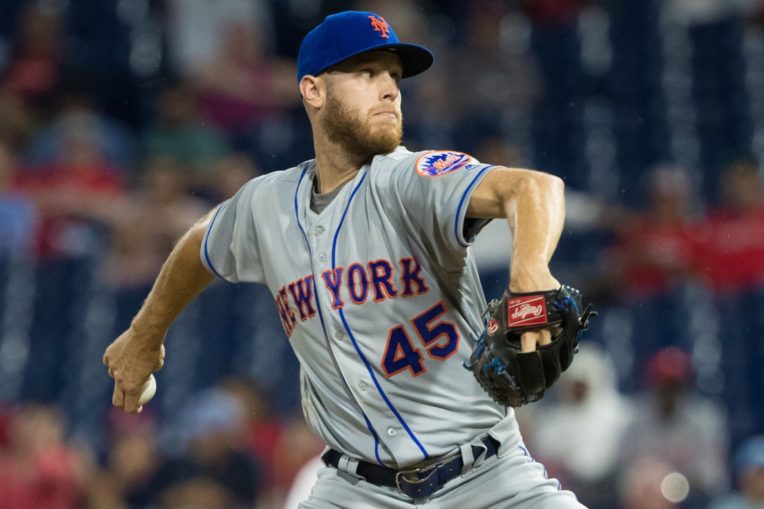
MMO: Moving on to the Mets. Their starting rotation showed significant improvements across the board in the second half under pitching coach Dave Eiland. He seems to have a mantra that the entire group is buying into. Jacob deGrom is probably considered as automatic as anyone else in the group, but Zack Wheeler, who a lot of folks are looking to as a key cog in this rotation, has a lot to live up to. Do you feel another step forward is in the cards for him?
ES: It’s certainly possible he takes a step forward. One of the things that’s nice about Wheeler is that he was the only pitcher on baseball last year to have five pitches with a 10 percent whiff rate or better (close; his four-seamer registered a 9.3 percent mark while his slider [12 percent], curve [13.2 percent], changeup [12.4 percent], and splitter [14.8 percent] all reached that threshold).
So he has five pitches that are really good and when he’s throwing 95 MPH he can get whiffs on all of them. As his command improves on all those secondary pitches and as he understands better how to sort of play with them, I see some similarities with Carlos Carrasco who has a large variety of pitches and was throwing 95 MPH when he was at his best. Also, some of the injury history that Carrasco had.
So there is a possibility for progression. My real main concern for the Mets starters is just injury. I think if they are all healthy this year it’s going to be maybe the best staff in baseball. I don’t know how you can really go up against Noah Syndergaard as a number-two, Wheeler as a three-four. It’s just a great combination of pitchers.
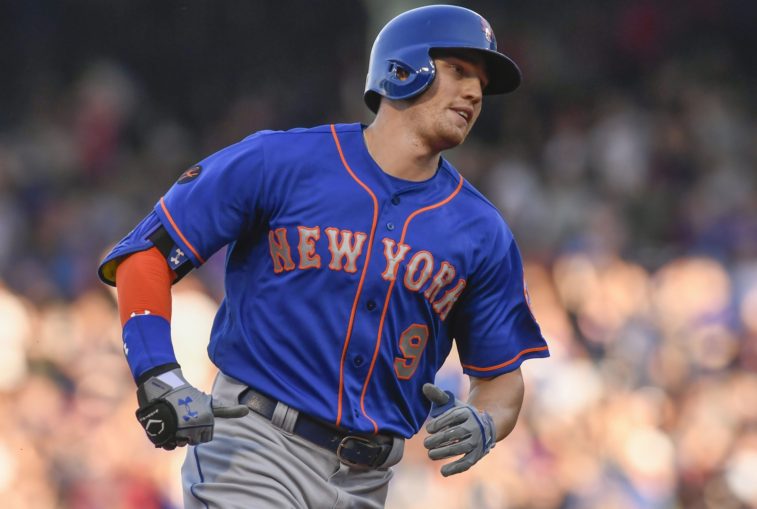
MMO: Over to the outfield — Brandon Nimmo had an unbelievable season last year, especially from the analytics side of things (.385 wOBA, 149 wRC+ rating). Do you think he’s able to sustain that level of production?
ES: Yeah, I think he’s going to regress on the power level a little bit (17 home runs in 2018). I mean, he just didn’t really show it before. His Statcast numbers don’t necessarily suggest that he’s going to hit for that type of power. But he does have elite plate discipline and I think that’s a good place to start. Especially, if he can really hone in on down the middle, that’s a great way to make the most out of his power.
There’s a small chance he turns into Joey Votto-type player, but most likely he’ll be a high-OBP, sort of 18-to-20 homer guy. Really good player, a great leadoff hitter, and a good enough outfielder. I think the fact they went out an got two centerfielders [in Keon Broxton and the incumbent Juan Lagares] means that they don’t really want Michael Conforto or Nimmo to play too much in centerfield.
MMO: As a fan base, we were kind of waiting for the other shoe to drop. Now we have two defensively-talented fourth outfielders pegged into centerfield, but we were thinking Brodie Van Wagenen would add another good corner outfielder and rotate everyone around. Now it appears they’re heading into the season with this group.
ES: It is a little weird, the fact that you’ve got two right-handers trying to platoon in centerfield. It’s not obvious to me but maybe they have splits where they feel like one of them is better against righties, that’s fine. But I do think maybe they’re just hoping that one of them will step forward between Broxton and Lagares.
One becomes an everyday guy, one becomes a fourth guy, and then when Yoenis Cespedes comes back there’s going to be a chance that you will see some Nimmo and Conforto in centerfield. By that time you would have developed Lagares or Broxton into kind of a super-sub. And as soon as you get a lead you can rest Cespedes’ heels or whatever you need to do.
MMO: That would be the ideal situation. You wrote a great article on Conforto’s productive second half last year and him coming into this year with a head full of steam. Do you think he’s bringing MVP-caliber play to the table this year?
ES: I think so. It’s hard to understate how much I love his plate approach and the way that he sprays his balls around. He has opposite-field power. I think he’s one of the best hitters in the league right now.
The shoulder injury was a difficult thing for him and I think you saw in the first half that — I don’t know if he came back too early — but he was still shaking the rust off. But if he can sustain that exit velocity that he showed in the second half once he was more healthy, I think you could see the kind of season where he’s got like a .280 batting average, close to a .400 OBP, and over a .500 slugging percentage because he’s that type of special player.
There have been some weird batted ball effects at Citi Field over the last few years and people have been talking about how the ball reacts differently in Citi Field. But I was looking into it and I think they’ve been working on it because the effect has gotten smaller every year over the last four years.
I think they’ve figured out that the ball was stored a little bit weirdly and they’re doing something about it. I know that Conforto had a weird one-year split and was bad at home last year (.211/.311/.371 at home; .271/.381/.514 on the road). I expect that to get ironed out.
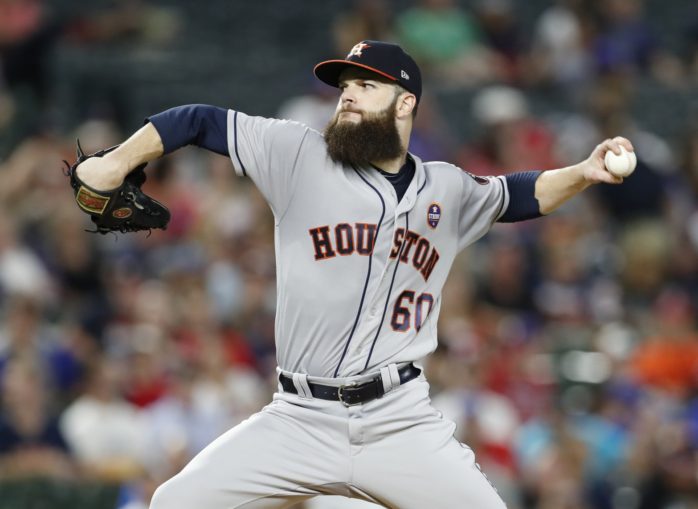
MMO: Do feel like the Mets have done enough to contend in the National League East?
ES: Well, I wish that they had spent more like the Yankees and pushed it another $20-to-$30 million. I think adding Dallas Keuchel or even a better sixth or seventh starter instead of Hector Santiago would have been nice.
Getting A.J. Pollock instead of Broxton might have been a better fit. But, it’s pretty obvious if you look through their past salary and what they’ve done, you know $150 million — I’m not sure if it’s a hard cap for them — but that’s basically where they stop spending.
Given the fact that they pushed it close to $150 million again, I love what they did. They have a lot of redundancy in the infield. With Jeff McNeil moving into the outfield I think they’ve got deeper depth out there. If Peter Alonso doesn’t work out, they’re fine. They can move Robinson Cano to first or Todd Frazier. If Jed Lowrie gets hurt, fine, you’ve got depth. If one of the corner guys go down, McNeil can play a little bit.
So I think they’ve done a really good job of creating redundancy. As a Mets fan, you’ll understand, injuries will come and it’s much better to have a plan. I think Adeiny Hechavarria was a good signing too. I wouldn’t say he’s a league-average player but I wouldn’t want Jed Lowrie playing short if Amed Rosario went down.
Lowrie, despite the potential injury (MRI was being taken at the time of the interview), I’ve been covering him and he’s a great addition to the clubhouse. Hopefully, the injury will just be a short-term thing and because does provide much-needed depth at multiple positions
So now you’ve got a real backup shortstop and with J.D. Davis and McNeil and Alonso all having options, you don’t have to have them on the major-league roster. So you can have veterans on the major-league roster and when someone gets hurt, then it’s time to call up Pete Alonso. I wouldn’t be surprised if Alonso, Davis, Luis Guillorme, all those guys, are in the minors to begin the year.
Then when the first injury happens they come up, and if they rake then they re-evaluate. I think in past years, the Mets have been like, “Well, we’re going as far as these rookie are going to take us because we don’t have any other plans”.
I’d just like to extend another huge thank you to Eno Sarris for taking the time to speak with Metsmerized. If you’re not already subscribing to The Athletic, Eno’s work is reason enough to plunk down the dues. Be sure to follow him on Twitter (@enosarris).


